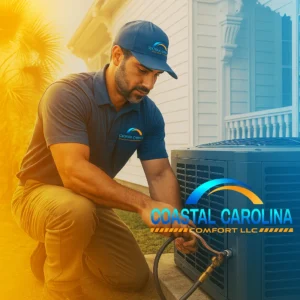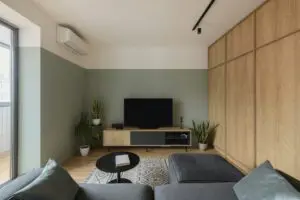Battlin’ with your AC like it’s a mid-summer showdown at high noon? Maybe it’s your thermostat throwin’ tantrums. Don’t sweat it, partner. Swap that cranky old timer for a shiny new Nest Learning Thermostat, gettin’ smarter while saving your pennies. Or saddle up with the Ecobee SmartThermostat, chattin’ your way to comfort with voice control. Honeywell Home T9‘s more your pace? It’s like a cozy blanket, adjusting just right. Prefer a touch of the future? Emerson Sensi Touch WiFi‘s your tech-savvy sidekick. Choose wisely, and y’all might just find the cool side of the pillow again. Poke around a bit more, and uncover which is your home’s new best buddy.
Understanding Faulty Thermostats
Well, if your thermostat’s acting more stubborn than a mule in mud, chances are it’s on the fritz. You’re likely nodding along, thinking, ‘Yep, that’s my thermostat alright.’ But how do you know for sure? That’s where symptom identification comes in.
If your home’s hotter than a summer barbecue or colder than your ex’s heart, those are telltale signs. Now, don’t go hitting it with a hammer just yet. We’ve got some troubleshooting tips that might just save the day.
First off, check if it’s playing dead or just needs new batteries. Sometimes, it’s as simple as giving it a good clean. Remember, you’re not alone in this. We’re all in the same boat, navigating the temperamental seas of home heating and cooling.
Nest Learning Thermostat
Now, if your old thermostat’s giving you the cold shoulder, it might be time to cozy up to the Nest Learning Thermostat. This clever gadget is like the smart cousin in the thermostat family who knows just how to save you a few bucks.
The installation process? It’s a breeze, almost as easy as pie. You’ll be guided through every step with instructions clearer than your grandma’s windowpanes.
And talk about energy savings – this thermostat learns your habits faster than you can say ‘lower my electric bill,’ adjusting your home’s temperature to keep your wallet happy.
Best Thermostat Replacements for AC Units
Ecobee SmartThermostat
If the Nest Learning Thermostat is the smart cousin, then the Ecobee SmartThermostat is the tech-savvy sibling who’s always one step ahead.
Picture this: You’re sprawled on the couch, popcorn in one hand, remote in the other, and you whisper, ‘Hey thermostat, make it cooler.’ Just like that, voice control has got your back, no need to pause your movie marathon.
And let’s talk about those energy reports. Ever wanted to know where your money’s going, down to the last penny? The Ecobee’s like that know-it-all friend, but instead of annoying, it’s actually saving you cash.
Welcome to the future, where your thermostat not only listens but learns. You’re part of the smart home crew now, enjoying comfort and savings with a laugh.
Honeywell Home T9
Stepping into the ring of smart home gadgets, the Honeywell Home T9 doesn’t just change the game; it plays by its own rules, making sure you’re always at the perfect temperature without breaking a sweat.
Now, what makes this thermostat the heavyweight champion of comfort and cost-cutting? Let’s break it down:
- Easy-Peasy Installation: With an installation guide clearer than your grandma’s instructions for reheating leftovers, you’ll have it up and running faster than you can say ‘Where’s the manual?’
- Smart Savings: This gadget’s got a knack for energy savings, trimming your bills like it’s mowing the lawn.
- Your Comfort, Their Command: It knows your cozy spot better than your dog does, ensuring you’re snuggled in just right, every season.
Y’all, joining the Honeywell Home T9 family is like finding out your home understands you—finally.
Emerson Sensi Touch WiFi
Diving into the world of smart thermostats, the Emerson Sensi Touch WiFi is like that tech-savvy friend who’s always got your back, making sure your home’s as cozy as a bug in a rug while keeping those energy bills in check.
Now, don’t you worry your pretty little head about setting it up; the installation guide is as clear as a sunny day in July, making it a walk in the park.
And let’s talk energy savings – this gadget’s so keen on cutting costs, you’d think it was pinching pennies for a living. It’s like having a thrifty guardian angel perched on your wall, whispering sweet nothings of savings into your ear.
Welcome to the family, where your comfort and wallet are always looked after.
Frequently Asked Questions
How Can I Determine if My Current Thermostat Is Compatible With My Existing HVAC System Before Purchasing a New One?
You’re pondering if your old thermostat will play nice with your HVAC, huh? Crack open that manual and check the wiring basics. Thermostat design ain’t rocket science but matching wires sure feels like it!
Are There Any Specific Tools or Professional Skills Required for the Installation of These Smart Thermostats, or Can It Be a DIY Project?
You’re diving into a sea of wires, but fear not! Installing smart thermostats is a DIY dance, if you’ve got the groove for wiring safety and a bit of spare installation time. No pros required!
What Are the Privacy Implications of Installing a Smart Thermostat Like the Nest Learning Thermostat or Ecobee Smartthermostat in My Home?
Installing a smart thermostat like Nest or Ecobee? You’re essentially inviting a nosy neighbor into your home, one that’s keen on your personal habits and loves data sharing. Welcome to the future, y’all!
How Do the Energy Savings of Smart Thermostats Compare to Traditional Models Over the Long Term, and Can They Justify the Initial Higher Investment
You’ll find smart thermostats can save ya a bundle over time, thanks to better seasonal efficiency. Don’t forget, government incentives might help with that upfront cost, making it a no-brainer for your wallet!
Can These Smart Thermostats Integrate With Other Smart Home Devices and Systems, and if So, Which Ones Are They Most Compatible With?
You betcha, those smart thermostats can chat with other smart devices like old pals! They’re chummy with gadgets supporting voice commands and geofencing features, making your home feel like one big, cozy smart family.
Conclusion
Alright, y’all, let’s wrap this up tighter than a squirrel’s winter stash.
If your thermostat’s gone haywire, leaving you hotter than a hen in a wool sweater, don’t sweat it. Swap that old clunker for a shiny new Nest Learning Thermostat, an Ecobee SmartThermostat that’s smarter than a fox in a henhouse, a Honeywell Home T9, or an Emerson Sensi Touch WiFi.
They’re the bee’s knees, and they’ll keep your den just as cozy as a bear’s cave in hibernation season.
So, go on, give your AC a little love with a thermostat upgrade that’s slicker than a greased pig!


